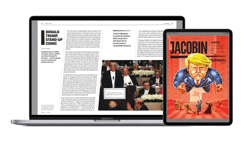
Reneé Doegar, commercial director of the London Review of Books, is looking forward to a quiet 2020 – relatively speaking. Following LRB’s recent fortieth anniversary celebrations which have been marked by special editorial, live events, merchandising and subscriptions marketing, a new LRB website will be live by the end of December. In the New Year, she confides, her hope is to draw breath long enough to get to grips with LRB’s suite of new online tools. But when we meet, it’s hard to contemplate Doegar in work mode doing down time.
A passionate and tireless subscription marketer and energetic LRB brand ambassador, Doegar has overseen a striking 42% growth in subscriptions and 65% growth in subscription revenue in the eight years since she joined the magazine, initially to run the marketing department. More recently, she was appointed commercial director, a new and more strategic role, working across the entire business (which also includes the London Review Bookshop and cake shop in Bloomsbury and an online store), with on-going subscriptions responsibility.
Recently nominated for six PPA Independent Publisher Awards (including independent publishing company of the year), LRB is Europe’s largest literary magazine – its latest ABC was 75,725 – and subscriptions, which account for 92% of this, are deeply important to the brand and always have been.

“The shift across the industry to digital reading, people’s feelings about what they want to pay for and what they value, the drop in print sales generally and the increase in cost have presented publishers with many challenges,” says Doegar. “The LRB has really bucked the trend with our consistent subscriptions growth. But that doesn’t mean it has been easy!”
Challenges differ brand to brand, of course, but for LRB with its long reads, the biggest come from competition for readers’ time – which means it is competing against, well, everything – and the general shift away from print. “For me, I think the LRB print product – along with the quality of our content – is key to our success,” she adds. “Print reminds them of what they’re paying for every two weeks, and some of our readers – even those who like to read it online – still value the physical product.”
Hand in hand with this, however, is the effort LRB puts into driving and maintaining its subscribers.
Print reminds them of what they’re paying for every two weeks.
LTV-based
“We are very lucky with how the company treats marketing,” Doegar believes. “We do everything here on Lifetime Value (a measure of the profit of an order over time), and we aim to break even on any piece of marketing by year three. This means we can try marketing initiatives that might not make money initially, but knowing we get good quality data means that the customer stays with us for years and brings profit. What this really means is not only are we growing circulation, we are growing the revenue made from that circulation even more.”
Every slice of live marketing is measured. At any time, the LRB will have around 500 different marketing ‘sources’ – executions, each with their own trackable URL – running live. This could be anything from a single display ad in a third party-owned product to an email campaign targeting 200,000 people, or simply a test ad in one of its own newsletters. And as the team do more things on a campaign basis, they have found that integrating campaigns across print, digital, social and so on has helped further improve results.
“In January, for example, we run an ‘Exercise for the Mind’ campaign with specific copy and imagery which we then adapted for every channel. Integrating our campaigns means that the message, offer and meaning all work better as a whole than as their component parts,” she says.
Every aspect of LRB’s strategy comes from data and modelling that data – something Doegar believes many publishers have stopped doing in recent years as data volumes grow.
“I think initiatives need to be run through Lifetime Value, and if you analyse everything you do and the assumptions you set up in the model are correct – you are onto a winning approach. The key to being good at this job is to test, iterate and keep evolving core activity. And not having all our subscriptions coming from one source or one campaign keeps us faster on our feet to adapt to changes, like GDPR or algorithmic changes by Facebook,” she says.
“My marketing philosophy is: let the data guide you.”
Every aspect of LRB’s strategy comes from data and modelling that data.
The right readers
Critical, too, is to find not just any readers but the right readers. Each year, LRB has to get about 40,000 new subscribers in order to grow by two to three thousand in circulation, Doegar explains. And it is much easier to do this by iterative improvements rather than find new subscribers from scratch each time. “If you run ten tests on your subs page a year and two of them produce a winning result, you can improve the conversion rate on your subs page by a couple of percentage points. This can increase your new subs by a couple of thousand a year,” she says. “That takes a lot less time and money than trying to find 2,000 new subscribers on an untested new channel.”
Anyone can buy growth with free copies or a great free gift, but Doegar wants more: not any reader, but the right reader. “I don’t want to get new subscriptions then lose 70% of them when their six-month trial ends – it’s not sustainable, or the kind of growth I’m looking for. I want slow growth that’s steady and profitable,” she explains. “In the past five years, circulation has gone up 16% but revenue from subscribers 59%. That’s what I mean by ‘good growth’.”
LRB’s main KPI for subscriptions is Lifetime Value which can show in the most granular way how something performs – a more sophisticated metric than ‘cost per acquisition’. “Sometimes, from a commercial viewpoint, we do things for wider reasons besides conversions. So, depending on the activity, the KPIs will change,” she continues. “Maybe we are doing something for email registrations to grow our list, or engagement / clicks to our site. The customer journey is a long and fascinating one, so I am careful to recognise the inherent and different value bands on the work we do as an organisation.”
I want slow growth that’s steady and profitable.
Birthday opportunities
LRB’s 40th anniversary has provided ample scope for many birthday-themed subscription-driving initiatives throughout 2019.
“It’s lovely to have a story to tell about the brand and a beautiful example of how many different areas of the company can come together, from the fantastic events series that kicked off in early October to the work we are doing on our digital site, to special deals like a 40th anniversary-themed £40 offer,” Doegar enthuses. “We reprinted our first issue from 1979 and put it in a binder for £19.79. As it has touched on every part of the business, the holistic nature of this campaign has been lovely. There’s also been some great merchandise we’ve developed for the LRB Store.”

LRB Store is a recent initiative, and Doegar’s idea. While LRB has long had its own, central London bookstore – which hosts high-profile literary readings – and a bijou tearoom, it launched its ecommerce site in late 2018 after noticing a surprising uplift in sales of branded tote bags … to Korean tourists.
“We’ve no idea how it happened – fashion trends can be the strangest things, and it wasn’t just happening to us but also a number of literary titles from around London – but demand for the bags suddenly escalated, quickly, and we ended up selling thousands,” Doegar reveals. “Late last year, I thought we should capitalise on this. So, we launched our ecommerce store and sold 7,000 items – from mouse mats to cover prints and, soon, candles – in its first eleven months.”
That’s the thing about LRB; its readers are as passionate as they are loyal – some subscribers have been on the books since LRB digitised its subscription list in the early 1990s. Meanwhile, the average age of its readership – which is currently around 53 though the spread is wider, with an academic skew – is coming down as tastes favour longer reads and LRB more actively targets students with a Netflix-style pay-a-little-less-a-little-more-often approach.
Moving into 2020, Doegar is eager to use the additional online tools built into the new website as part of a wider rethink of all LRB’s digital assets to further understand and optimise the user journey, analysing improved data around recommendation engines to extend their stay. A plan to update the LRB app, further optimise LRB’s mobile usability, and a possible paywall strategy, as well as staying ahead of further market changes are also on her New Year’s to-do list.
The key to being good at this job is to test, iterate and keep evolving core activity.
Small, but agile
“I really believe that all subs marketers in publishing are doing the same things and all can learn from one another, and actually we independent publishers are often getting some stuff right more often than the big players,” she says.
“That sounds pretentious, I know, but it’s really just because the nature of working for a single title affords us the luxury of real focus. So, while a 90-title organisation may struggle to see all of the communications they send out, for example, we have a retention manager who can focus entirely on our welcome series, engagement metrics, and iterative renewal testing. This means we can read every single piece of independent review feedback that comes in and respond to it or read every individual cancellation reason. It means we can react to something live, change something on the site, or iterate a template based on a test result, or change artwork on a landing page.
“In other words, it means no one is closer to what we do than we are.”
Collectively, all of this means greater agility and creativity – and all underpinned by data-informed educated decisions. And it is collectively, too, that Doegar believes the publishing industry will prosper. She has learned much from talking to flagship titles to find out what works for them, she says, and she is not precious about disclosing what works at LRB.
“I think we all succeed as an industry if we help one another as much as possible,” Doegar states firmly. “We must keep sharing ideas.”
I think we all succeed as an industry if we help one another as much as possible.
This article was first published in InPublishing magazine. If you would like to be added to the free mailing list, please register here.












